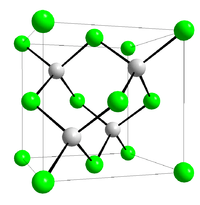Aluminium antimonide
 | |
| Identifiers | |
|---|---|
| 25152-52-7 | |
| 3D model (Jmol) | Interactive image |
| ChemSpider | 82452 |
| ECHA InfoCard | 100.042.410 |
| EC Number | 246-667-3 |
| PubChem | 91307 |
| |
| |
| Properties | |
| AlSb | |
| Molar mass | 148.742 g/mol |
| Appearance | black crystals |
| Density | 4.26 g/cm3 |
| Melting point | 1,060 °C (1,940 °F; 1,330 K) |
| Boiling point | 2,467 °C (4,473 °F; 2,740 K) |
| insoluble | |
| Band gap | 1.58 eV |
| Refractive index (nD) |
3.3 |
| Structure | |
| Zinc blende | |
| T2d-F-43m | |
| Tetrahedral | |
| Thermochemistry | |
| Std molar entropy (S |
65 J/mol K |
| Std enthalpy of formation (ΔfH |
-50.4 kJ/mol |
| Hazards | |
| Safety data sheet | MSDS |
| NFPA 704 | |
| 317 °C (603 °F; 590 K) | |
| Except where otherwise noted, data are given for materials in their standard state (at 25 °C [77 °F], 100 kPa). | |
| | |
| Infobox references | |
Aluminium antimonide (AlSb) is a semiconductor of the group III-V family containing aluminium and antimony. The lattice constant is 0.61 nm. The indirect bandgap is approximately 1.6 eV at 300 K, whereas the direct band gap is 2.22 eV.
Its electron mobility is 200 cm²·V−1·s−1 and hole mobility 400 cm²·V−1·s−1 at 300 K. Its refractive index is 3.3 at a wavelength of 2 µm, and its dielectric constant is 10.9 at microwave frequencies.[1]
AlSb can be alloyed with other III-V materials to produce the following ternary materials: AlInSb, AlGaSb and AlAsSb.
Aluminum antimonide is rather flammable because of the reducing tendency of the antimonide (Sb3−) ion. It burns to produce aluminum oxide and antimony trioxide.
See also
References
- ↑ K Seeger and E Schonherr "Microwave dielectric constant of aluminium antimonide" Semicond. Sci. Technol. 6 (1991) 301 doi:10.1088/0268-1242/6/4/013
This article is issued from Wikipedia - version of the 9/4/2016. The text is available under the Creative Commons Attribution/Share Alike but additional terms may apply for the media files.
